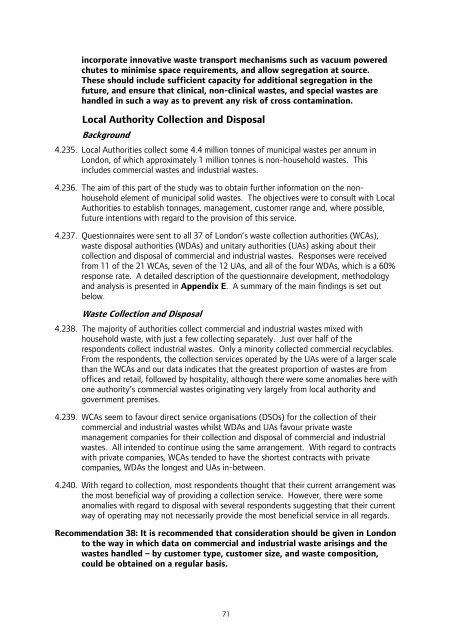London Wider Waste Strategy - London - Greater London Authority
London Wider Waste Strategy - London - Greater London Authority
London Wider Waste Strategy - London - Greater London Authority
Create successful ePaper yourself
Turn your PDF publications into a flip-book with our unique Google optimized e-Paper software.
incorporate innovative waste transport mechanisms such as vacuum powered<br />
chutes to minimise space requirements, and allow segregation at source.<br />
These should include sufficient capacity for additional segregation in the<br />
future, and ensure that clinical, non-clinical wastes, and special wastes are<br />
handled in such a way as to prevent any risk of cross contamination.<br />
Local <strong>Authority</strong> Collection and Disposal<br />
Background<br />
4.235. Local Authorities collect some 4.4 million tonnes of municipal wastes per annum in<br />
<strong>London</strong>, of which approximately 1 million tonnes is non-household wastes. This<br />
includes commercial wastes and industrial wastes.<br />
4.236. The aim of this part of the study was to obtain further information on the nonhousehold<br />
element of municipal solid wastes. The objectives were to consult with Local<br />
Authorities to establish tonnages, management, customer range and, where possible,<br />
future intentions with regard to the provision of this service.<br />
4.237. Questionnaires were sent to all 37 of <strong>London</strong>’s waste collection authorities (WCAs),<br />
waste disposal authorities (WDAs) and unitary authorities (UAs) asking about their<br />
collection and disposal of commercial and industrial wastes. Responses were received<br />
from 11 of the 21 WCAs, seven of the 12 UAs, and all of the four WDAs, which is a 60%<br />
response rate. A detailed description of the questionnaire development, methodology<br />
and analysis is presented in Appendix E. A summary of the main findings is set out<br />
below.<br />
<strong>Waste</strong> Collection and Disposal<br />
4.238. The majority of authorities collect commercial and industrial wastes mixed with<br />
household waste, with just a few collecting separately. Just over half of the<br />
respondents collect industrial wastes. Only a minority collected commercial recyclables.<br />
From the respondents, the collection services operated by the UAs were of a larger scale<br />
than the WCAs and our data indicates that the greatest proportion of wastes are from<br />
offices and retail, followed by hospitality, although there were some anomalies here with<br />
one authority’s commercial wastes originating very largely from local authority and<br />
government premises.<br />
4.239. WCAs seem to favour direct service organisations (DSOs) for the collection of their<br />
commercial and industrial wastes whilst WDAs and UAs favour private waste<br />
management companies for their collection and disposal of commercial and industrial<br />
wastes. All intended to continue using the same arrangement. With regard to contracts<br />
with private companies, WCAs tended to have the shortest contracts with private<br />
companies, WDAs the longest and UAs in-between.<br />
4.240. With regard to collection, most respondents thought that their current arrangement was<br />
the most beneficial way of providing a collection service. However, there were some<br />
anomalies with regard to disposal with several respondents suggesting that their current<br />
way of operating may not necessarily provide the most beneficial service in all regards.<br />
Recommendation 38: It is recommended that consideration should be given in <strong>London</strong><br />
to the way in which data on commercial and industrial waste arisings and the<br />
wastes handled – by customer type, customer size, and waste composition,<br />
could be obtained on a regular basis.<br />
71
















